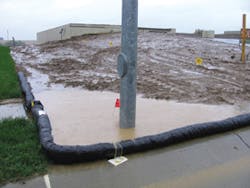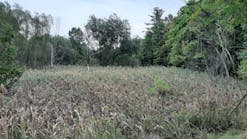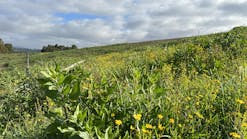When wildfires strike southern California-and they strike often-two things are likely. First, news crews take to the airwaves to describe the latest devastation. Second, behind the scenes, it is often Michael Harding preparing for what comes next.
“The secondary disaster is always the ash and sediment that comes down and injures people. That’s where I get involved, trying to prevent that,” says Harding, CPESC, of Great Circle International and former president of the International Erosion Control Association.
“We can do that, in a number of different ways. Our focus is generally on source control, where we try to get up on the burned slopes to protect them from erosion with some sort of mulch. But this takes time, particularly on the size acreages we’re dealing with, so we simultaneously install diversions or catchment systems around people’s homes to protect them from mudflows until stabilizing vegetation is reestablished.
“I generally teach that for most types of projects, you try to work from the top down using erosion control BMPs [best management practices]. You first try to control sediment by keeping it in place before it gets mobilized. But in fire work, it’s sort of the opposite. The first thing we do is try to protect houses and people’s structures and roads. We’ll assign work crews from the California Conservation Corps to go out behind people’s homes, businesses, and critical evacuation roads to install k-rails [lane dividers] or sand or gravel bags to try and divert the mud around the homes, because we know it’s going to come with the first rains. These efforts are focused on high-priority sites where lives and property are at stake. That’s generally a subset of the overall burn area that’s referred to as the “˜urban interface.’ For example, in the San Diego County fire in 2007, we had 435,000 acres that burned. For economic as well as practical environmental reasons, we typically treat between 1% and 2% of that overall total. These treatments can range from hydraulic applications to straw wattles to gravel bags and k-rails.
“Typically, after a fire incident, we spend the first few days and weeks conducting assessments to determine which areas are at greatest risk. I say “˜we’ because this is a coordinated team effort between the local sponsoring governmental agency-in 2003 and 2007 it was San Diego city and county-and the federal agencies such as FEMA and the NRCS Emergency Watershed Program, the groups who eventually provide the funds for remediation. I’ve been real fortunate to be included as part of the Geosyntec Consultants’ team in 2003 and 2007, and we work right alongside the local, state, and federal folks to get the assessments done rapidly and secure the necessary funds to pay for all the upcoming work. That’s important, because the big-ticket BMPs don’t proceed until assessments are completed, agreement is reached among the team on treatments, and the money is dedicated.
“While that work is being completed, we send out the California Conservation Corps crews to install the exigency measures, such as sand and gravel bags, which can sometimes appear backward from what you would do on a regular job, where you do the source control first. We also have the CCC install wattles on the slopes in advance of hydraulic applications, which takes some coordination to make sure the activities of diverse groups of contractors and CCC crews are phased properly. That’s where the county inspectors and Geosyntec field engineers really prove their worth. And then there’s my partner Chuck Austin and his son, David, who coordinated the activities of the hydraulic contractors in 2003 and 2007. Enough credit cannot be given for their efforts.
“Once we get the hydraulic mulching on the slopes, it pretty much stops all the sediment delivery and makes our sediment control even more efficient.”
Harding laments the fact that often people knowingly or unwittingly put themselves in harm’s way by virtue of where they live or build their homes. “It’s hard to control development in California. My wife Carol used to say, “˜People buy airspace.’ They buy small plots of land, in areas where it is difficult to protect them from fire, and they build upwards. Berkeley, in 1991, was a great example. People built along old logging roads in the East Bay hills. Their homes had a small footprint that caused them to cantilever their houses out over the steep hillsides. When the fire started, it raced up the hills, right up underneath them. You’d see a lot of burnt-out cars down in the canyons because even the garages were cantilevered over the edges.
“If you really want to protect people from fire incidents, you don’t let them build in areas where they can’t be protected,” he adds. “But I don’t know that that’s possible in California or on the front range of the Rockies. People are going to build where they can afford to build. Land use planning really gets to the issue, but I think in many areas in California it’s probably a little bit late for that.”
He notes that since the 1930s, many communities, such as areas in Pasadena and Glendale, CA, have built large debris basins at the base of large hills. This can be an effective measure, he says, “but communities have to have the funds to do that.” In places where homes are backed by a wilderness area or where homes are built at the toe of the slopes, these large debris catchments could provide some protection: “These devices act as a containment buffer behind homes for mud and debris flows. I think a lot of the structures that can collect runoff and divert it around people’s homes should be designed and built as part of the community itself, but they’re not. To go back in and retrofit communities with this type of protection is very costly, and the federal government doesn’t use its disaster remediation money to pay for that.”
A frequent discussion after wildfires, Harding says, is whether to seed denuded areas or let them reseed naturally. Most of the time it appears that decisions to seed or not to seed are not made based on valid technical information, but rather on emotional or political sentiment. For example, he comments that after the fire in Berkeley, an individual who appeared to see the disaster as a window of opportunity to reestablish native vegetation told him, “If you let this place regenerate on its own, in 300 years, it’s going to be giant redwoods.” In response, Harding quipped, “You know, I don’t think the homeowners are willing to wait that long.”
Experience has taught him that many factors must enter into the decision-making process regarding choice of sediment control. “Anybody who knows anything about sediment control knows that it will not work unless you maintain it. We put in 1,187 check dams in the East Bay hills in 1991 after the fire-1,187 of them-and they were all made from straw bales, something we don’t do any more. After the first rain, they were all pretty much full, with no way to go in and maintain them, so they failed in later rains. We don’t specify straw bales any more, because they are never maintained. Nowadays, we tend to use gravel-filled burlap bags as check structures, sometimes sandbags if we want to divert things, and we try to minimize their use as well because of future maintenance issues; funding is available to place them but not to maintain them.”
Another issue is cost. “The biggest issue after a fire for me and the team professionally is making sure you’re doing the right thing and that you’re cognizant of the expense of it, because people are cheerleaders for doing work after a fire, but six months down the road, they’re wanting to know why you spent all that money. So you make sure that everything you do is economically defensible, but you also make sure it is done correctly. You’ve got to do it right, and you’ve got to do it fast, and it’s got to be economically defensible. I always say that 95% of this work is political and 5% of it is technical. In our industry, most people know what to do to control erosion; it’s just a question of getting everything in a row and working within the framework of the emergency management agencies, to make sure that what we do is approved and gets paid for. I understand that the County of San Diego got every nickel back from the 2003 San Diego County Fire effort, but only on the day they started to address the remediation work for the 2007 fire.”
Inlet Protection in Charleston
Bryan Cook is one of the principals of Integrated Site Management in South Carolina, and his firm does quite a bit of work in the local home-building industry. “In this industry, you have lots that are completed and stabilized, adjacent to lots that are under construction,” he explains. “So you have situations, especially in high-flow areas, where silt fence doesn’t necessarily work, and a standard inlet protection built with a silt fence and reinforced frames doesn’t typically work.”
“We got into that situation with a client in Charleston, SC. We have been working in this development weekly-it’s a very long-term project. In the low country of Charleston, typically it’s very flat; there’s not much topographical relief. You have to have something that can really move the water but still clear the sediment. If [someone pays] about a quarter of a million dollars for a house, the last thing they want to see is dirty water rising into their yard.”
Cook tried a number of options, but was generally unhappy with the results. “We used one BMP with a DOT [Department of Transportation] fabric and reinforced frame, then we also used a hardware cloth with the aggregate base around the reinforced frames. None of those could filter the water and the sediment out quickly enough. The typical BMPs that are custom to our area weren’t satisfactory. The time that the water took to get through the system in a rain event was backing the water up into the nearby homeowners’ vegetated lots. The client was receiving phone calls from them, obviously, about water getting close to their foundations. It’s a situation the client didn’t want, so he called us out to look at it to provide some solutions and recommendations.”
After much research and trial and error, Cook settled on Gutter Eels for curb inlet protection, and for immediately before water enters the sewer, he installed Silt-Savers. “They are remarkable products, and do an extremely good job,” he comments.
The Gutter Eel and Silt-Saver products have been severely challenged by the weather. “We had three rain events in the last three or four months since we installed those, pushing 15- to 20-year rain events,” Cook says. “That’s a tremendous amount of water, and, again, in low country where we have a flat area, you have a lot of water that builds up quickly before it gets to its final destination in the sediment pond, before it exits the site.”
“Another reason we use the Gutter Eel,” he adds, “is specifically in the event we have unforeseen storms, hurricanes, or tropical depressions. Sometimes the DOT requires-and some of our site-specific engineers require-a rock bag, and a rock bag completely closes the throat of an inlet, which provides no relief. The Gutter Eel has a built-in weir, which allows the opening in the throat to receive the same amount of water with the weir installed.”
Cook reports good durability for both the Gutter Eel and the Silt-Saver. “Regarding the Silt-Savers, we’ve had them installed for almost four months, and we have not had to replace them yet. We also do our weekly maintenance, but the fabric on the product is a polyethylene HDPE [high-density polyethylene], and it has extremely good durability. Also, this is an active construction site. There are accidents that occur, and the structure the fabric sits on is also made of polyethylene, an HDPE product that has some structural rigidity to it.
“The good thing about the Gutter Eel,” he continues, “is that it is composed of recycled tires for the base element instead of rock, which is used in rock bags. Rock bags are not durable. If several vehicles or street sweepers, over the life of the job, hit a rock bag, the aggregate inside the bag gets out onto the pavement, which then mars the pavement, and the municipalities don’t appreciate that. They come back to the developer, saying “˜You have to repair the asphalt.’ But the Gutter Eel has that recycled rubber, so in the event one does rupture or break the fabric, you’re dealing with rubber, which can be swept up and doesn’t harm the pavement surface.”
Although regular maintenance is required, Cook finds that the job can be handled easily and efficiently. “We provide turnkey maintenance programs for our clients. We install all the initial BMPs for the community, and then we do a weekly maintenance. Part of our maintenance program includes street sweeping. The great thing about this whole process is that after a rain event, the sediment collects in front of the Gutter Eel, in front of the BMP. The fine material collects in the aggregate of the Gutter Eel, but the heavy sediments actually stay at the asphalt, and in our weekly maintenance, we come by with our gutter broom and our sweeper and remove all the sediment into our hopper.
“With the Silt-Saver, the silt collects outside of the fabric, and we have our maintenance crews come by when it gets built up. It’s all very, very efficient. In today’s market, you have to be efficient. If you’re not, you can’t be competitive.”
Reacting to an Altered Drainage Pattern
Construction on new housing development began in the St. Louis suburb of O’Fallon, MO, in 2005. The primary developer, however, ran out of funding, and his portion of the project came to a standstill.
The master plan, though, called for a new road to be built, and the city of O’Fallon built the road, with part of it traversing a corner of this developer’s now-defunct project. Rob Carrothers, president of Soil-Tek of Mid-America, explains what then happened. “It had always been in the development’s plans for this road to go through there, only when the city had forecast that it would be doing this, the infrastructure for the development should have already been in-but it wasn’t, because of the slowdown in the economy.”
When the road was built, Carrothers says, “It caused a change in the drainage pattern. What it did was concentrate a great deal of runoff in a 24-inch outflow that redirected the drainage on our property from a wide, sweeping sheet flow into a pretty concentrated area.” He notes that during large storms, part of this property was cascading silt and water onto the street, as well as into the area where another developer was building new homes. Carrothers’s solution? “It took extensive grading, along with some temporary sediment devices called Filtersoxx, made by Filtrexx.
“We put in some temporary sediment basins, but those couldn’t hold [the runoff from] what the city finally ended up doing with the road project. So now what we’ve done is to enlarge those further, and put in more Filtersoxx. We’re actually going to collect that water and pipe it to our detention area 300 feet away, so that we can in fact control the runoff better. We also ended up reseeding about 80 acres that needed to have good vegetative cover to get the land stable.”
Another problem Carrothers faced is that the site contains a large wetland, about 10 acres in size. “What we were most interested in doing,” he says, “was protecting that wetland so it didn’t become fouled with sediment. That was the primary reason we wanted to make sure the detention area didn’t get overwhelmed with the new drainage pattern. They were afraid that if it got overwhelmed, runoff would just cascade down this property and into that wetland.”
Maintaining Efficiency in the Midwest
Silt fence has its place in the toolbox of erosion control experts, but Jeff Patten is not a big fan of it. His company, Rocbox Construction Services in Tulsa, OK, works with local homebuilders to control sediment runoff from construction sites. He found a workable solution as a result of a problem at his own house.
“I built a house about a year and a half ago,” Patten explains, “and the municipality where I live was starting to use new national guidelines on erosion control. The builder I was using was red-tagged, not for anything that he was doing wrong, but because he wasn’t keeping the silt fence up. Here in the middle part of the country, we get thunderstorms, sometimes 1 to 3 inches of rain overnight, and it would knock a regular silt fence down. We needed something new that was subcontractor-friendly, so I went out looking and found the Gator Guard and ordered a small amount of it. It just took off from there. One builder told another builder, who told another builder, and now I’ve got about 15 builders that buy from me.”
Patten has taken the time to learn his customers’ needs. “These are not guys who have huge construction projects. They treat every construction project as its own entity, and it almost has its own set of books. Every house has to make money, has to have a profit margin. And you’re talking about a profit margin of 8% to 10% sometimes on these smaller houses. In this part of the country you’re talking about a $125,000 house, so you’re looking at a $10,000 profit margin, and you can’t spend $5,000 on erosion control. You need something that’s fast, something that works.
“The black silt fence would blow down, so three or four times during a six-month build they would have to go out and redo their erosion control. This particular product, Gator Guard-they put it down, and as long as it’s installed correctly, it works out. Another reason builders are using it is that, if you’re building a house next to someone who’s living there, and if you get dirt in somebody else’s yard, they tend to get upset. When you put this stuff down, it keeps the neighbors a little happier.”
On occasion, Patten has tried other solutions. “Sometimes we put out hay bales; a few builders here put out wattles that have hay in them. But the hay bales will last a couple of thunderstorms, and they start falling apart. And the regular wattles, if you don’t trench them in real good, you’ll get washout underneath them. With the Gator Guard, if you put it in right and pin it, a lot of times you don’t have to put a lot of dirt on it, it’ll work by itself.”
Patten has been impressed by the Gator Guard’s durability and ease of repair. Although the manufacturer clearly warns that vehicular traffic over its product may cause it to fail, Patten notes, “You can drive over it with a regular truck, like a half-ton or three-quarter-ton truck. After 10 or 20 times, it might get a hole in it, but another great thing about it is you can pull out your pocket knife, cut it, and take two zip ties and tie the ends off, pull them together, and you’ve just repaired it. It’s really a good product. I think builders around the country would really benefit from it. In this part of the country, for a small lot-say, 60 feet by 120 feet-you don’t go out and hire a company that trenches in silt fence, because it costs too much to do that.”
Soon, Patten will be experimenting with another use of the Gator Guard product. “I had a developer call me yesterday,” he says, “and he’s got a development that’s on a hill. They usually take down trees where a street or where the water lines are going to go. When you start taking down all that vegetation, especially on a hill, problems can quickly develop. The developer said, “˜I’ve seen you put this stuff [Gator Guard] out; can it help on a hill like this?’ I told him we can rig this stuff up a hill, and he’s going to get a little bit of erosion coming down to it, but when you get that, the best thing to do is to pack on some sod and get vegetation growing again. I don’t know too many products that could keep a hill from coming down when you take the vegetation off of it. The municipality where this development is going on is getting pretty serious about shutting him down if he doesn’t find a way to control his erosion.”
Another useful sediment-control device, Patten adds, is pressure-run gravel, “which is a type of gravel that when water hits it, it gets kind of solid.” A number of municipalities in his region require that builders place at least 4 inches of this pressure-run gravel on driveways, which helps control sediment runoff when vehicles are entering and leaving the construction site.
Destroying and Reestablishing a Soccer Field
Fargo, ND, population 99,000, is situated along the Red River on the state’s eastern border with Minnesota. The Red River frequently floods in the spring, but in late March 2009, the river rose to unprecedented levels, topping 40 feet in a channel whose flood stage stands at 18 feet.
The city maintains a permanent 43-foot dike, but with this record flooding, crews rushed to build temporary emergency dikes and levees around the community. George Sholy, co-owner of S&S Landscaping in Fargo, describes the unique approach taken by the city: “Over at Centennial School, when they were working on the flood here, they went into a soccer field and started excavating dirt out of the field, digging holes about 30 feet deep, to get enough clay to build the dikes around the town.”
Similarly, at Discovery School, “During the flood, they just came into the school. There was a big hunk of land, and they dug the clay out, and that’s what they used to build the dikes. The holes were huge-they removed hundreds of thousands of yards of dirt. The Centennial School site was about an eight-acre site, with about five acres of dirt taken out. The other site was probably about 350 feet by 350 feet and had pretty deep holes also.”
The clay from the two schools was taken in April, and when the floodwaters finally receded, the dirt and clay was returned to the school grounds. That’s where Sholy’s S&S Landscaping firm entered the picture.
“There was just a tremendous amount of debris after that.” Sholy says. “The dirt was put back by about June, then they brought some topsoil in at the end of August or the first part of September and regraded the area that was a soccer field. It was tough to get it all smooth again. We didn’t backfill the clay, but we had to go in and restore the turf. There was silt fence put up around the site, and there was inlet protection put in around the site, such as Dandy Curb Sacks.
“Those are basically for temporary inlet protection and are put in until we have turf establishment. Once the turf is established, they get taken out. They require little maintenance. If they get closed up, they can get cleaned out and reused. Usually, after a big rain event, those bags are checked. If they’re about a third full, we take them out and clean them and put them back in.” Sholy notes that the sacks can be reused several times.
A similar project Sholy has been working on involves a new road the city of Fargo is building. “They raised the road probably three to five feet high, because it’s right along the river. They’re using the road kind of as a dike. On that particular project, we used floating silt fence in the Red River, and we used lots and lots of straw wattles along the riverbank. And we’ve been using Dandy Curb Sacks on that one. We haven’t seeded yet, but that particular project is going to get seeded and straw mulched, with a turf reinforcement mat used on the river side of the raised road.”
Sholy comments, “We’ve used different things-rock bags, weighted wattles-but I think the Dandy bag is fast, easy to put in, and quite reliable. With rock bags, if there’s traffic going on, people might hit the rock bags and break them apart, and then they’re not working any longer. With the Dandy, they can drive right over the top of it, and not damage it at all.”
He adds, “The Dandy Curb Sack is a below-the-grade sack, and we always get them with overflow ports, just in case there’s a really big rain. It collects the sediments and works very well.”






